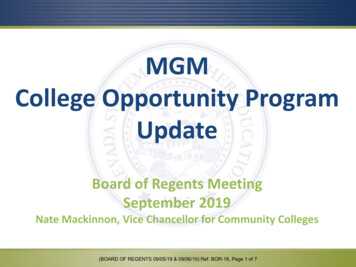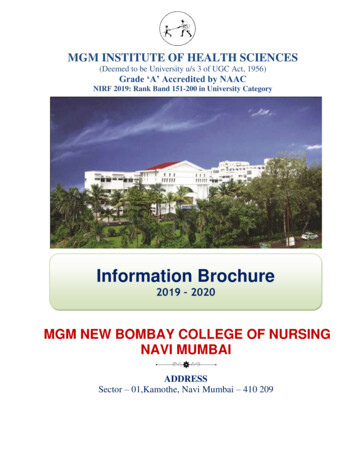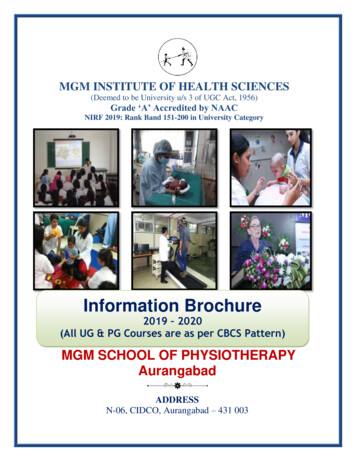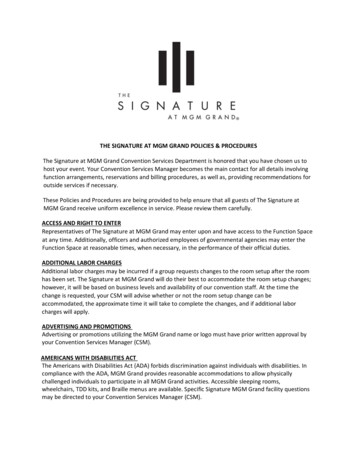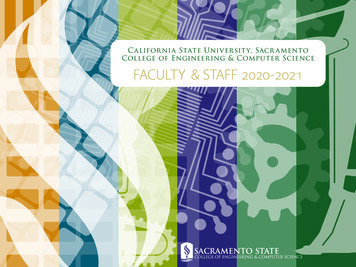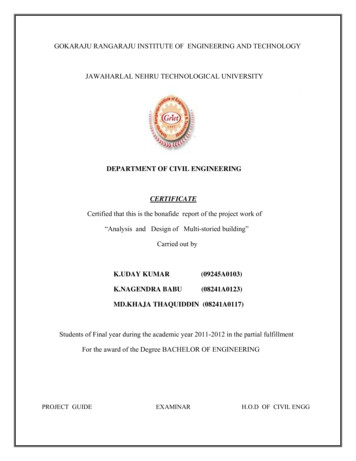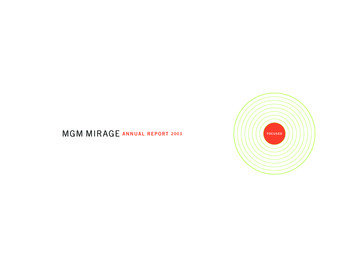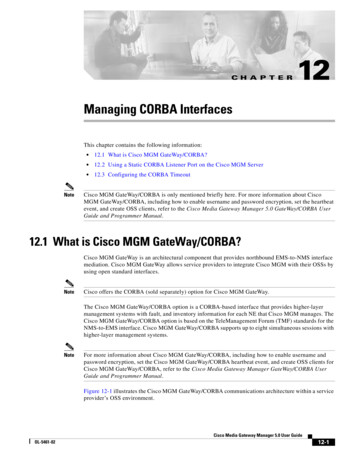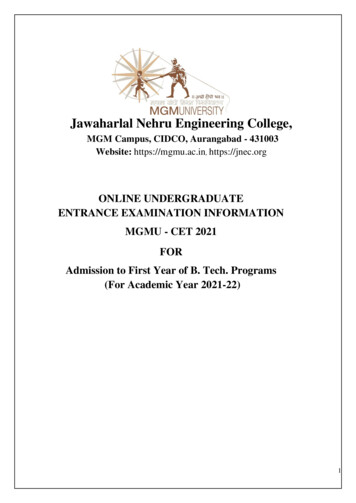
Transcription
Jawaharlal Nehru Engineering College,MGM Campus, CIDCO, Aurangabad - 431003Website: https://mgmu.ac.in, https://jnec.orgONLINE UNDERGRADUATEENTRANCE EXAMINATION INFORMATIONMGMU - CET 2021FORAdmission to First Year of B. Tech. Programs(For Academic Year 2021-22)1
MGMU - CET 2021 INFORMATIONMGMU - CET 2021INDEX1EXAMINATION SCHEDULE FOR MGMU - CET 202142INTRODUCTION53DEFINITIONS54SCHEME OF EXAMINATION & SYLLABUS55ELIGIBILITY FOR APPEARING TO MGMU - CET 2021166ONLINE APPLICATION FORM177ONLINE MGMU - CET 2021188DECLARATION OF RESULT199LEGAL JURISDICTION1910CONDUCT AND DISCIPLINE192
MGMU - CET 2021 INFORMATIONADMISSION TO B. TECH. PROGRAMMES FOR ACADEMIC YEAR 2021 - 2022Jawaharlal Nehru Engineering College (JNEC), MGM University, Aurangabad invitesapplications to its four year on-campus B.Tech. Under graduation programs for the academicyear 2021-2022. Admissions are open for the following programs to be offered in MGMUniversity, Aurangabad.UG ProgramsName of The ProgramApproved IntakeDurationB. Tech. Chemical Engineering304 yearsB. Tech. Civil Engineering1204 yearsB. Tech. Computer Science and Engineering1204 yearsB. Tech. Electrical Engineering604 yearsB. Tech. Electronics andTelecommunicationsEngineering1204 yearsB. Tech. Information Technology604 yearsB. Tech. Mechanical Engineering1204 years3
MGMU - CET 2021 INFORMATION1. EXAMINATION SCHEDULE FOR MGMU - CET 2021Important Information for Online Entrance Examination ( Proctored examination)Online registration & Confirmation of Application formon websiteExamination Fees Rs. 900/-Already startedPay only through online mode08/07/2021 to 10/07/202110 AM and 2 PMTentative Date and TimeDuration of Examination03 HOURS.EXAMINATION SCHEDULEActivityLog in to Juno ERP moduleFirst Login to read the instructions.Commencement of Online Examination.End of Online Examination.Display of Candidate response in his / her log-inSubmission of objections on Question PaperDeclaration of ResultShift 19.30 AM9:50 AM10:00 AM1:00 PMShift 21:30 PM1:50 PM2:00 PM5:00 PMSchedule will be notified and declaredseparatelyWithin 24 hrs. after the examination isoverThe result will be communicated to thecandidate on the registered email ID.4
MGMU - CET 2021 INFORMATION2. INTRODUCTIONThe MGM University Aurangabad has established "ADMISISON REGULATINGAUTHORITY and In-charge COMMON ENTRANCE TEST CELL" as per theMaharashtra Act No XXVI of 2019).The In-charge of MGMU - CET 2021, appointed by the competent authority, isauthorized to conduct MGMU - CET 2021 for the academic year 2021-22.The Registrar, MGM University Aurangabad has notified the rules to regulate theadmissions to the First Year of Full Time Professional Undergraduate Technicalprograms (Engineering and Technology). The admissions shall be carried out as perthese rules and its amendment from time to time.The In-charge MGMU - CET 2021 cell, shall act as Nodal Officer for the MGMU CET 2021.3. DEFINITIONS. (a) “Act” means the MGM University, Aurangabad (Regulation of admission and fees)Act, 2019 Act XXVI of 2019.(b) “All India Seats” means seats available to an eligible Indian National Candidate;(c) “Application Form” means prescribed form filled up online by the Candidate foradmission;(d) “Competent Authority” means the Registrar, MGMU Aurangabad.(e) “Program” means the undergraduate technical courses in Engineering andTechnology.(f)“Eligible Candidates” means the candidates who are eligible for differentprofessional courses as notified by the MGMU, Aurangabad.(g) “HSC” means the Higher Secondary School Certificate (Standard XII) examinationconducted by Maharashtra State Board of Secondary and Higher SecondaryEducation or its equivalent certificate awarded by a recognized Boards;(h) “Inter-Se-Merit” means the order of merit in respect of various classes/category ofCandidates;(i)“Qualifying Examination” means examinations on the basis of which a candidatebecomes eligible for admission or its equivalent examination;(j)“SSC” means the Secondary School Certificate (Standard X) examination conductedby Maharashtra State Board of Secondary and Higher Secondary Education or itsequivalent certificate awarded by a recognized Boards;4. SCHEME OF EXAMINATION Date of Examination:The examination will be conducted in ON-LINE PROCTORED MODE across theMaharashtra as well as outside Maharashtra State tentatively from 08th July 2021 to10th July 2021 for PCM group. Weightage and Pattern of Examination:MGMU - CET 2021 will be conducted for PCM group (Physics, Chemistry andMathematics). The question paper has multiple choice questions (MCQ) having 45
MGMU - CET 2021 INFORMATIONoptions. There will be no Negative Marking. The questions will be mainlyapplication based. No marks are awarded for questions not attempted. The questionswill be selected at random from a large question bank. All the questions andinstructions of the test will be in English only.The number of questions and marking system is as follows:SubjectMathematicsPhysicsChemistry Number of MultipleChoiceQuestions (MCQ)505050Mark(s) perQuestion21Total MarksDuration inMinutes1009010090Syllabus for MGMU - CET 2021 Examination:The MGMU - CET 2021 will be conducted based on syllabus of Physics, Chemistry andMathematics subjects. The detailed syllabus for MGMU - CET 2021 is as follows,MATHEMATICSUNIT 1: SETS, RELATIONS AND FUNCTIONS:Sets and their representation: Union, intersection and complement of sets and their algebraicproperties; Power set; Relation, Type of relations, equivalence relations, functions; one-one, intoand onto functions, the composition of functions.UNIT 2: COMPLEX NUMBERS AND QUADRATIC EQUATIONS:Complex numbers as ordered pairs of reals, Representation of complex numbers in the form 𝑎 𝑖𝑏 and their representation in a plane, Argand diagram, algebra of complex number, modulusand argument (or amplitude) of a complex number, square root of a complex number, triangleinequality, Quadratic equations in real and complex number system and their solutions Relationsbetween roots and coefficient, nature of roots, the formation of quadratic equations with givenroots.UNIT 3: MATRICES AND DETERMINANTS:Matrices, algebra of matrices, type of matrices, determinants and matrices of order two and three,properties of determinants, evaluation of determinants, area of triangles using determinants,Adjoint and evaluation of inverse of a square matrix using determinants and elementarytransformations, Test of consistency and solution of simultaneous linear equations in two or threevariables using determinants and matrices.UNIT 4: PERMUTATIONS AND COMBINATIONS:The fundamental principle of counting, permutation as an arrangement and combination assection, Meaning of 𝑃 (𝑛, 𝑟) and 𝐶 (𝑛, 𝑟), simple applications.UNIT 5: BINOMIAL THEOREM AND ITS SIMPLE APPLICATIONS:Binomial theorem for a positive integral index, general term and middle term, properties ofBinomial coefficients and simple applications.UNIT 6: SEQUENCE AND SERIES:Arithmetic and Geometric progressions, insertion of arithmetic, geometric means between twogiven numbers, Relation between A.M and G.M sum up to n terms of special series;6
MGMU - CET 2021 INFORMATION𝑆𝑛, 𝑆𝑛2, 𝑆𝑛3. Arithmetico-Geometric progression.UNIT 7: LIMIT, CONTINUITY AND DIFFERENTIABILITY:Real–valued functions, algebra of functions, polynomials, rational, trigonometric, logarithmicand exponential functions, inverse function. Graphs of simple functions. Limits, continuity anddifferentiability. Differentiation of the sum, difference, product and quotient of two functions.Differentiation of trigonometric, inverse trigonometric, logarithmic, exponential, composite andimplicit functions; derivatives of order up to two, Rolle’s and Lagrange's Mean value Theorems,Applications of derivatives: Rate of change of quantities, monotonic Increasing and decreasingfunctions, Maxima and minima of functions of one variable, tangents and normal.UNIT 8: INTEGRAL CALCULAS:Integral as an anti-derivative, Fundamental Integrals involving algebraic, trigonometric,exponential and logarithms functions. Integrations by substitution, by parts and by partialfunctions. Integration using trigonometric identities.Evaluation of simple integrals of the ��(𝑝𝑥 𝑞)𝑑𝑥(𝑝𝑥 𝑞)𝑑𝑥 𝑥 2 𝑎2 , 2 2 , 𝑎2 𝑥 2 , 𝑎2 𝑥 2 , 𝑎𝑥 2 𝑏𝑥 𝑐 , 𝑎𝑥 2 𝑏𝑥 𝑐 , 𝑎𝑥 2 𝑏𝑥 𝑐 , 𝑎𝑥 2 𝑏𝑥 𝑐 ,𝑥 𝑎 𝑎 2𝑥2 𝑑𝑥, 𝑥 2 𝑎2 𝑑𝑥Integral as limit of a sum. The fundamental theorem of calculus, properties of definite integrals.Evaluation of definite integrals, determining areas of the regions bounded by simple curves instandard form.UNIT 9: DIFFRENTIAL EQUATIONS:Ordinary differential equations, their order and degree, the formation of differential equations,solution of differential equation by the method of separation of variables, solution of ahomogeneous and linear differential equation of the type𝑑𝑦 𝑝(𝑥) 𝑞(𝑥)𝑑𝑥UNIT 10: CO-ORDINATE GEOMETRY:Cartesian system of rectangular coordinates in a plane, distance formula, sections formula, locusand its equation, translation of axes, the slope of a line, parallel and perpendicular lines,intercepts of a line on the co-ordinate axis.Straight lineVarious forms of equations of a line, intersection of lines, angles between two lines, conditionsfor concurrence of three lines, the distance of a point form a line, equations of internal andexternal by sectors of angles between two lines coordinate of the centroid, orthocentre andcircum-centre of a triangle, equation of the family of lines passing through the point ofintersection of two lines.Circle, conic sectionsA standard form of equations of a circle, the general form of the equation of a circle, its radiusand central, equation of a circle when the endpoints of a diameter are given, points ofintersection of a line and a circle with the centre at the origin and condition for a line to betangent to a circle, equation of the tangent, sections of conics, equations of conic sections(parabola, ellipse and hyperbola) in standard forms, condition for𝑌 𝑚𝑥 𝑐 to be a tangent and point (s) of tangency.UNIT 11: THREE DIMENSIONAL GEOMETRY:Coordinates of a point in space, the distance between two points, section formula, directionsratios and direction cosines, the angle between two intersecting lines. Skew lines, the shortestdistance between them and its equation. Equations of a line and a plane in different forms, theintersection of a line and a plane, coplanar lines.UNIT 12: VECTOR ALGEBRA:7
MGMU - CET 2021 INFORMATIONVectors and scalars, the addition of vectors, components of a vector in two dimensions and threedimensional space, scalar and vector products, scalar and vector triple product.UNIT 13: STATISTICS AND PROBABILITY:Measures of discretion; calculation of mean, median, mode of grouped and ungrouped datacalculation of standard deviation, variance and mean deviation for grouped and ungrouped data.Probability: Probability of an event, addition and multiplication theorems of probability, Baye'stheorem, probability distribution of a random variate, Bernoulli trials and binomial distribution.UNIT 14: TRIGONOMETRY:Trigonometrical identities and equations, trigonometrical functions, inverse trigonometricalfunctions and their properties, heights and distance.PHYSICSUNIT 1: PHYSICS AND MEASUREMENT:Physics, technology and society, S I Units, fundamental and derived units, least count, accuracyand precision of measuring instruments, Errors in measurement, Dimensions of Physicsquantities, dimensional analysis and its applications.UNIT 2: KINEMATICS:The frame of reference, motion in a straight line, Position- time graph, speed and velocity;Uniform and non-uniform motion, average speed and instantaneous velocity, uniformlyaccelerated motion, velocity-time, position-time graph, relations for uniformly acceleratedmotion, Scalars and Vectors, Vector. Addition and subtraction, zero vector, scalar and vectorproducts, Unit Vector, Resolution of a Vector. Relative Velocity, Motion in a plane, ProjectileMotion, Uniform Circular Motion.UNIT 3: LAWS OF MOTION:Force and inertia, Newton’s First law of motion; Momentum, Newton’s Second Law of motion,Impulses; Newton’s Third Law of motion. Law of conservation of linear momentum and itsapplications. Equilibrium of concurrent forces. Static and Kinetic friction, laws of friction, rollingfriction. Dynamics of uniform circular motion: centripetal force and its applications.UNIT 4: WORK, ENERGY AND POWER:Work done by a content force and a variable force; kinetic and potential energies, work-energytheorem, power.The potential energy of spring conservation of mechanical energy, conservativeand neoconservative forces; Elastic and inelastic collisions in one and two dimensions.UNIT5: ROTATIONAL MOTIONCentre of the mass of a two-particle system, Centre of the mass of a rigid body; Basic concepts ofrotational motion; a moment of a force; torque, angular momentum, conservation of angularmomentum and its applications; the moment of inertia, the radius of gyration.Values of moments of inertia for simple geometrical objects, parallel and perpendicular axestheorems and their applications. Rigid body rotation equations of rotational motion.UNIT 6: GRAVITATION:The universal law of gravitation. Acceleration due to gravity and its variation with altitude anddepth. Kepler’s law of planetary motion. Gravitational potential energy; gravitational potential.Escape velocity, Orbital velocity of a satellite. Geo stationary satellites.UNIT 7: PROPERTIES OF SOLIDS AND LIQUIDS:Elastic behaviour, Stress-strain relationship, Hooke's Law. Young's modulus, bulk modulus,8
MGMU - CET 2021 INFORMATIONmodulus of rigidity. Pressure due to a fluid column; Pascal's law and its applications. Viscosity.Stokes' law. terminal velocity, streamline and turbulent flow. Reynolds number. Bernoulli'sprinciple and its applications. Surface energy and surface tension, angle of contact, application ofsurface tension - drops, bubbles and capillary rise. Heat, temperature, thermal expansion; specificheat capacity, calorimetry; change of state, latent heat. Heat transfer-conduction, convection andradiation. Newton's law of cooling.UNIT 08: OSCILLATIONS AND WAVES:Periodic motion - period, frequency, displacement as a function of time. Periodic functions.Simple harmonic motion (S.H.M.) and its equation; phase: oscillations of a spring -restoringforce and force constant: energy in S.H.M. - Kinetic and potential energies; Simple pendulum derivation of expression for its time period: Free, forced and damped oscillations, resonance.Wave motion. Longitudinal and transverse waves, speed of a wave. Displacement relation for aprogressive wave. Principle of superposition of waves, a reflection of waves. Standing waves instrings and organ pipes, fundamental mode and harmonics. Beats. Doppler Effect in sound.UNIT 09: ELECTROSTATICS:Electric charges: Conservation of charge. Coulomb's law-forces between two-point charges,forces between multiple charges: superposition principle and continuous charge distribution.Electric field: Electric field due to a point charge, Electric field lines. Electric dipole, Electricfield due to a dipole. Torque on a dipole in a uniform electric field.Electric flux. Gauss's law and its applications to find field due to infinitely long uniformlycharged straight wire, uniformly charged infinite plane sheet and uniformly charged thinspherical shell. Electric potential and its calculation for a point charge, electric dipole and systemof charges; Equipotential surfaces, Electrical potential energy of a system of two-point charges inan electrostatic field.Conductors and insulators. Dielectrics and electric polarization, capacitor, the combination ofcapacitors in series and parallel, capacitance of a parallel plate capacitor with and withoutdielectric medium between the plates. Energy stored in a capacitor.UNIT 10: CURRENT ELECTRICITY:Electric current. Drift velocity. Ohm's law. Electrical resistance. Resistances of differentmaterials. V-l characteristics of Ohmic and non-ohmic conductors. Electrical energy and power.Electrical resistivity. Colour code for resistors; Series and parallel combinations of resistors;Temperature dependence of resistance.Electric Cell and its Internal resistance, potential difference and emf of a cell, a combination ofcells in series and parallel. Kirchhoff’s laws and their applications. Wheatstone bridge. MetreBridge. Potentiometer - principle and its applications.UNIT 11: MAGNETICEFFECTSOF CURRENT AND MAGNETISM:Biot - Savart law and its application to current carrying circular loop. Ampere's law and itsapplications to infinitely long current carrying straight wire and solenoid. Force on a movingcharge in uniform magnetic and electric fields. Cyclotron.Force on a current-carrying conductor in a uniform magnetic field. The force between twoparallel current carrying conductors- definition of ampere. Torque experienced by a current loopin a uniform magnetic field: Moving coil galvanometer, its current sensitivity and conversion toammeter and voltmeter. Current loop as a magnetic dipole and its magnetic dipole moment. Barmagnet as an equivalent solenoid, magnetic field lines; Earth's magnetic field and magneticelements. Para-, dia- and ferromagnetic substances. Magnetic susceptibility and permeability.Hysteresis. Electromagnets and permanent magnets.UNIT 12: ELECTROMAGNETIC INDUCTION AND ALTERNATING CURRENTS:Electromagnetic induction: Faraday's law. Induced emf and current: Lenz’s Law, Eddy currents.Self and mutual inductance. Alternating currents, peak and RMS value of alternating current/9
MGMU - CET 2021 INFORMATIONvoltage: reactance and impedance: LCR series circuit, resonance: Quality factor, power in ACcircuits, wattless current. AC generator and transformer.UNIT 13: ELECTROMAGNETIC WAVES:Electromagnetic waves and their characteristics, Transverse nature of electromagnetic waves,Electromagnetic spectrum (radio waves, microwaves, infrared, visible, ultraviolet. X-rays.Gamma rays), Applications of e.m. waves.UNIT 14: OPTICS:Reflection and refraction of light at plane and spherical surfaces, mirror formula. Total internalreflection and its applications. Deviation and Dispersion of light by a; prism; Lens Formula.Magnification. Power of a Lens. Combination of thin lenses in contact. Microscope andAstronomical Telescope (reflecting and refracting) and their magnifying powers.Wave optics: wavefront and Huygens' principle. Laws of reflection and refraction usingHuygens principle. Interference, Young's double-slit experiment and expression for fringe width,coherent sources and sustained interference of light. Diffraction due to a single slit, width ofcentral maximum. Resolving power of microscopes and astronomical telescopes. Polarization,plane-polarized light: Brewster's law, uses of plane-polarized light and Polaroid.UNIT 15: DUAL NATURE OF MATTER AND RADIATIONDual nature of radiation. Photoelectric effect. Hertz and Lenard's observations; Einstein'sphotoelectric equation: particle nature of light. Matter waves-wave nature of particle, de Broglierelation. Davisson-Germer experiment.UNIT 16: ATOMS AND NUCLEIAlpha-particle scattering experiment; Rutherford's model of atom; Bohr model, energy levels,hydrogen spectrum. Composition and size of nucleus, atomic masses, isotopes, isobars: isotones.Radioactivity- alpha. beta and gamma particles/rays and their properties; radioactive decay law.Mass-energy relation, mass defect; binding energy per nucleon and its variation with massnumber, nuclear fission and fusion.UNIT 17: ELECTRONIC DEVICESSemiconductors; semiconductor diode: 1- V characteristics in forward and reverse bias; diode asa rectifier; I-V characteristics of LED. the photodiode, solar cell and Zener diode; Zener diode asa voltage regulator. Junction transistor, transistor action, characteristics of a transistor: transistoras an amplifier (common emitter configuration) and oscillator. Logic gates (OR. AND. NOT.NAND and NOR). Transistor as a switch.UNIT 18: COMMUNICATION SYSTEMSPropagation of electromagnetic waves in the atmosphere; Sky and space wave propagation. Needfor modulation. Amplitude and Frequency Modulation, Bandwidth of signals. the bandwidth ofTransmission medium, Basic Elements of a Communication System (Block Diagram only).CHEMISTRYUNIT 1: STATES OF MATTER:Matter and its nature, Dalton's atomic theory: Concept of atom, molecule, element andcompound: Physical quantities and their measurements in chemistry, precision and accuracy,significant figures. S. I. Units, dimensional analysis: Laws of chemical combination; Atomic andmolecular masses, mole concept, molar mass, percentage composition, empirical and molecularformulae: Chemical equations and stoichiometry.Classification of matter into solid, liquid and gaseous states.10
MGMU - CET 2021 INFORMATIONGaseous State: Measurable properties of gases: Gas laws - Boyle's law, Charle’s law. Graham'slaw of diffusion, Avogadro's law, Dalton's law of partial pressure; Concept of Absolute scale oftemperature; Ideal gas equation; Kinetic theory of gases (only postulates); Concept of average,root mean square and most probable velocities; Real gases, deviation from Ideal behavior,compressibility factor and van der Waals equation.Liquid State: Properties of liquids - vapor pressure, viscosity and surface tension and effect oftemperature on them (qualitative treatment only).Solid State: Classification of solids: molecular, ionic, covalent and metallic solids, amorphousand crystalline solids (elementary idea); Braggs Law and its applications: Unit cell and lattices,packing in solids (fcc, bcc and hcp lattices), voids, calculations involving unit cell parameters, animperfection insolids; Electrical and magnetic properties.UNIT 2: ATOMIC AND MOLECULAR STRUCTURE:Thomson and Rutherford atomic models and their limitations; Nature of electromagneticradiation, photoelectric effect; Spectrum of the hydrogen atom. Bohr model of a hydrogen atom its postulates, derivation of the relations for the energy of the electron and radii of the differentorbits, limitations of Bohr's model; Dual nature of matter, de Broglie's relationship. Heisenberguncertainty principle. Elementary ideas of quantum mechanics, quantum mechanics, thequantum mechanical model of the atom, its important features. Concept of atomic orbitals asone-electron wave functions: Variation of ψ and ψ2 with r for 1s and 2s orbitals; various quantumnumbers (principal, angular momentum and magnetic quantum numbers) and their significance;shapes of s, p and d - orbitals, electron spin and spin quantum number: rules for filling electronsin orbitals - Aufbau principle, Pauli's exclusion principle and Hund's rule, electronic configurationof elements, extra stability of half-filled and completely filledorbitals.Chemical bonding and molecular structure: Kossel - Lewis’s approach to chemical bondformation, the concept of ionic and covalent bonds.Ionic bonding: Formation of ionic bonds, factors affecting the formation of ionic bonds;calculation of lattice enthalpy.Covalent bonding: Concept of electronegativity, Fajan’s rule, dipole moment: Valence ShellElectron pair repulsion (VSEPR) theory and shapes of simple molecules.Quantum mechanical approach to covalent bonding: Valence bond theory - its important features,the concept of hybridization involving s, p and d orbitals; Resonance.Molecular orbital theory - Its important features LCAOs, types of molecular orbitals (bonding,antibonding), sigma and pi-bonds, molecular orbital electronic configurations of homonucleardiatomic molecules, the concept of bond order, bond length and bond energy. Elementary idea ofmetallic bonding. Hydrogen bonding and its applications.UNIT 3: THERMODYNAMICS:Basic concepts: System and surroundings, extensive and intensive properties, state functions,types of processes.The first law of thermodynamics - Concept of work, heat internal energy and enthalpy, heatcapacity, molar heat capacity; Hess’s law of constant heat summation; Enthalpies of bonddissociation, combustion, formation, atomization, sublimation, phase transition, hydration,ionization and solution.The second law of thermodynamics - Spontaneity of processes; ΔS of the universe and ΔG of thesystem as criteria for spontaneity. ΔG (Standard Gibbs energy change) and equilibriumconstant.UNIT 4: PHYSICAL AND CHEMICAL EQUILIBRIA:Different methods for expressing the concentration of solution – molality, molarity, molefraction, percentage (by volume and mass both), the vapor pressure of solutions and Raoult'sLaw - Ideal and non-ideal solutions, vapor pressure - composition, plots for ideal and non-idealsolutions; Colligative properties of dilute solutions - a relative lowering of vapor pressure,depression of freezing point, the elevation of boiling point and osmotic pressure; Determination11
MGMU - CET 2021 INFORMATIONof molecular mass using colligative properties; Abnormal value of molar mass, Van’t Hoff factorand its significance.Equilibrium: Meaning of equilibrium, the concept of dynamic equilibrium.Physical equilibrium: Solid-liquid, liquid - gas and solid-gas equilibria, Henry's law. Generalcharacteristics of equilibrium involving physical processes.Chemical equilibrium: Law of chemical equilibrium, equilibrium constants (Kp and Kc) and theirsignificance, the significance of ΔG and ΔG in chemical equilibrium, factors affecting equilibriumconcentration, pressure, temperature, the effect of catalyst; Le Chatelier’s principle.Ionic equilibrium: Weak and strong electrolytes, ionization of electrolytes, various concepts ofacids and bases (Arrhenius. Bronsted-Lowry and Lewis) and their ionization, acid-base equilibria(including multistage ionization) and ionization constants, ionization of water. pH scale, commonion effect, hydrolysis ofsalts and pH of their solutions, the solubility of sparingly soluble salts andsolubility products, buffer solutions.UNIT 5: REDOX REACTIONS AND ELECTROCHEMISTRY:Electronic concepts of oxidation and reduction, redox reactions, oxidation number, rules forassigning oxidation number, balancing of redox reactions.Electrolytic and metallic conduction, conductance in electrolytic solutions, molar conductivitiesand their variation with concentration: Kohlrausch’s law and its applications.Electrochemical cells - Electrolytic and Galvanic cells, different types of electrodes, electrodepotentials including standard electrode potential, half - cell and cell reactions, emf of a galvaniccell and its measurement: Nernst equation and its applications; Relationship between cellpotential and Gibbs' energy change: Dry cell and lead accumulator; Fuel cells.UNIT 6: CHEMICAL KINETICS:Rate of a chemical reaction, factors affecting the rate of reactions: concentration, temperature,pressure and catalyst; elementary and complex reactions, order and molecularity of reactions, ratelaw, rate constant and its units, differential and integral forms of zero and first-order reactions,their characteristics and half-lives, the effect of temperature on the rate of reactions, Arrheniustheory, activation energy and its calculation, collision theory of bimolecular gaseous reactions (noderivation).Surface Chemistry: Adsorption- physisorption and chemisorptions and their characteristics,factors affecting adsorption of gases on solids - Freundlich and Langmuir adsorption isotherms,adsorption from solutions. Catalysis: Homogeneous and heterogeneous, activity and selectivityof solid catalysts, enzyme catalysis and its mechanism. Colloidal state: distinction among truesolutions, colloids and suspensions, classification of colloids - lyophilic, lyophobic;multimolecular, macromolecular and associated colloids (micelles), preparation and properties ofcolloids - Tyndall effect. Brownian movement, electrophoresis, dialysis, coagulation andflocculation: Emulsions and their characteristics.UNIT 7: PROPERTIES OF ELEMENTS AND ISOLATION OF METALS:Classification of elements and periodicity in properties: Modem periodic law and present form ofthe periodic table, s, p. d and f block elements, periodic trends in properties of elements atomicand ionic radii, ionization enthalpy, electron gain enthalpy, valence, oxidation states and chemicalreactivity. General principles and processes of isolation of metals: Modes of occurrence ofelements in nature, minerals, ores; Steps involved in the extraction of metals - concentration,reduction (chemical and electrolytic methods) and refining with special reference to theextraction of Al. Cu, Zn and Fe; Thermodynamic and electrochemical principles involved in theextraction of metals.12
MGMU - CET 2021 INFORMATIONUNIT 8: HYDROGEN AND S-BLOCK ELEMENTS:Hydrogen: Position of hydrogen in periodic table, isotopes, preparation, properties anduses of hydrogen; physical and chemical properties of water and heavy water; structure,preparation, reactions and uses of hydrogen peroxide; classification of hydrides - ionic,covalent and interstitial; hydrogen as a fuel.s-block elements (alkali and alkaline earth metals):Group 1 and 2 Elements: General introduction, electronic configuration and general trendsin physical and chemical properties of elements, anomalous properties of the first elementof each group, diagonalrelationships.Preparation and properties of some important compounds - sodium carbonate and sodiumhydroxide and sodium hydrogen carbonate; Industrial uses of lime, limestone. Plaster ofParis andcement: biological significance of Na, K. Mg and Ca.UNIT 9: P- , D- AND F- BLOCK ELEMENTS:p-block elements: General introduction, Electronic configuration and general trends inphysical and chemical properties of elements across the periods and down the groups;unique behavior of the first element in each group.Groupwise study of the p – block elements,Group -13: Preparation, properties and uses of boron and aluminum; Structure, propertiesand uses of borax, boric acid, diborane, boron trifluoride, alum
Jawaharlal Nehru Engineering College (JNEC), MGM University, Aurangabad invites applications to its four year on-campus B.Tech. Under graduation programs for the academic year 2021-2022. . Log in to Juno ERP module 9.30 AM 1:30 PM First Login to read the instructions. 9:50 AM 1:50 PM Commencement of Online Examination. 10:00 AM 2:00 PM
